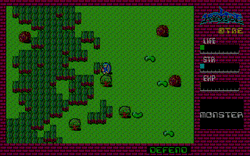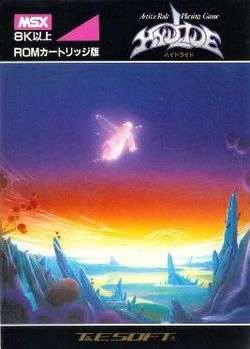Hydlide
|
Front cover of the MSX version of Hydlide. | |
| Developer(s) | T&E Soft |
|---|---|
| Publisher(s) |
T&E Soft FCI (NES) |
| Designer(s) | Tokihiro Naito[1] |
| Programmer(s) | Eiji Kato |
| Platform(s) | PC-6001, PC-8801, MSX, MSX2 FM-7, PC-9801, Sharp X1, PC-66, FM7, Sharp MZ-2000, Famicom/NES[1] |
| Release date(s) |
PC-6001 & PC-8801 ‹See Tfd› MSX ‹See Tfd› FM-7 ‹See Tfd›
MSX2 ‹See Tfd› PC-9801 ‹See Tfd›
Famicom / NES ‹See Tfd› |
| Genre(s) | Action role-playing game |
| Mode(s) | Single-player |
Hydlide (ハイドライド Haidoraido) is a 1984 action role-playing video game developed and published by T&E Soft. It was originally released for the NEC PC-6001 and PC-8801 computers in 1984, in Japan only;[5] ports for the MSX, MSX2 (a separate port released on 3.5" floppy), FM-7 and NEC PC-9801 were released the following year.[6] A Nintendo Famicom version was first released under the name Hydlide Special on March 18, 1986 in Japan; three years later, in June 1989, that version saw a North American release for the Nintendo Entertainment System by FCI, its title having been returned to simply Hydlide.[6] The game sold 2 million copies in Japan, across all platforms.[1]
In April 28, 1995, a remake was released for the Sega Saturn under the title Virtual Hydlide, both in Japan and western countries.
Storyline
In the kingdom of Fairyland, three magic jewels were enshrined in the palace to maintain peace in the kingdom. One day, an evil man broke into the palace and stole one of the three magic jewels. Without the third jewel, the two remaining jewels lost their magic sparkle. The magic spell that sealed the power of Varalys, the most vicious demon in the kingdom, was broken. During the turmoil which followed, the last two jewels were stolen. Varalys cast a special magic on Princess Ann, turning her into three fairies, and hid her somewhere in the kingdom. He then let loose a horde of monsters across the land and became the ruler of the kingdom.
Finally, the young knight Jim stood up and took action to restore peace in the kingdom. He bravely made his way into the wilderness in full armor to fight the monsters...
Characters
- Jim: Hero
- Ann: Princess
- Varalys: Villain
Development
According to the game's creator, Tokohiro Naito, the game was inspired by The Tower of Druaga and The Black Onyx. His idea behind Hydlide was to mix together action and RPG elements into a new Action-RPG genre. Naito noted that he was completely unaware of Western RPGs like Ultima and Wizardry when he was developing Hydlide. He also stated that he only became aware of two other similar Action-RPGs, Dragon Slayer and Courageous Perseus, while reading a magazine during Hydlide's development, and was shocked to find that Hydlide was not the only Action-RPG in development. He felt threatened by Courageous Perseus, which looked visually impressive, but underestimated Dragon Slayer, which he found visually unimpressive.[7]
Reception and legacy

Hydlide was one of the first action role-playing games, along with Courageous Perseus[1][7] and Dragon Slayer.[7][8] Hydlide was initially well received and considered an innovator when released in Japan back in 1984. Some of these innovations include being able to switch between attack mode and defense mode, quick save and load options which can be done at any moment of the game through the use of passwords as the primary back-up, and the introduction of a health regeneration mechanic where health and magic slowly regenerate when standing still. Hydlide was also an early open world game,[9] and the first role-playing game that rewarded exploration in an open world environment.[10]
It sold 2 million copies in Japan, including 1 million for home computers (including the PC-88, PC-98, PC-66, Sharp X1, FM7, MSX, MSX2, and MZ-2000) and 1 million for the Famicom console.[1] It was the first computer game to receive a Platinum award from Toshiba EMI for a million sales.[7]
The game had an influence on the acclaimed action RPG series, Ys, which, for example, uses a similar health-regeneration mechanic.[11] The recharging health mechanic first introduced by Hydlide in 1984 would, decades later, become a common mechanic widely used in many video games,[11] including shooter games such as Halo.[1] Hydlide's open world game design inspired Hideo Kojima, who designed Metal Gear Solid V so that it captures the open-world feel he felt when he first played Hydlide on PC.[9] Platinum Games director Hideki Kamiya was inspired by the Hydlide series, which he cited as an influence on Scalebound, an open world action RPG.[12][13]
The NES version of Hydlide is infamously known for its repetitive music that bears similarity to John Williams' Indiana Jones theme. This is because it is one of the only two RPG/Adventure games made for the Family Computer (NES) without bankswitched memory; the other, Enix's adventure game PORTOPIA Renzoku Satsujin Jiken, has no music at all.
For whatever reason, the game was never released outside of Japan except for a 1989 localization of Special, simply called Hydlide. With no context, this release was treated as a brand new game. It was completely reviled by every single contemporary reviewer and continues to be reviled today, often compared unfavorably to the first The Legend of Zelda.
Sequels
Hydlide had several follow-ups:
- Hydlide II: Shine of Darkness was originally released for the NEC PC-8801 in 1985 and then ported to the MSX in Japan.[14] An official English version was released through the Dutch MSX games distribution platform WOOMB.net in late 2006, the first official release outside Japan. The game introduced a morality meter, where the player can be aligned with Justice, Normal, or Evil. Killing humans or good monsters lowers the player's morality, while fighting evil monsters increases it. If the player has an evil alignment, the townsfolk will ignore the player, denying access to certain clues, dialogues, equipment, and training. The game also introduced a time option, allowing the player to speed up or slow down the gameplay.[5]
- Hydlide 3: The Space Memories was released in 1987 for the MSX in Japan; a Family Computer version (with the subtitle 闇からの訪問者 = yami kara no houmonsha = visitor from darkness) was released in Japan in 1989. The game retains the morality meter of its predecessor and expands the time option with an in-game clock and a need to sleep and eat. The game uses four distinct character classes. This game was also re-released through the Dutch MSX games distribution platform WOOMB.net in late 2006, with an English translation.[5]
- Super Hydlide is an updated port of Hydlide 3 released for the Sega Genesis. It was released in Japan in 1989, in North America in 1990, and in Europe in 1991.
- Virtual Hydlide is a 1995 remake of Hydlide, still developed by T&E Soft but released exclusively for the Sega Saturn. It uses pseudo-3D graphics, a live action player character, and a system which creates a new game world for each game by randomly selecting from sets of pre-designed level maps.
References
- 1 2 3 4 5 6 John Szczepaniak, History of Japanese Video Games, Kinephanos, ISSN 1916-985X
- ↑ "Hydlide (PC88)". Famitsu. Retrieved 2015-01-14.
- ↑ http://www.famitsu.com/cominy/?m=pc&a=page_h_title&title_id=28201
- ↑ http://www.famitsu.com/cominy/?m=pc&a=page_h_title&title_id=23423
- 1 2 3 Kurt Kalata & Robert Greene. "Hydlide". Hardcore Gaming 101. Retrieved 2011-05-01.
- 1 2 "Hydlide". GameFAQs. Retrieved 16 February 2012.
- 1 2 3 4 John Szczepaniak (2016), The Untold History Of Japanese Game Developers, Volume 2, page 49
- ↑ Kurt Kalata, Dragon Slayer, Hardcore Gaming 101
- 1 2 https://twitter.com/hideo_kojima_en/status/470783176634163200
- ↑ http://in.ign.com/india/82586/feature/ign-india-discusses-game-design-combat-in-open-world-games
- 1 2 Szczepaniak, John (7 July 2011). "Falcom: Legacy of Ys". GamesTM (111): 152–159 [153]. Retrieved 2011-09-07. (cf. Szczepaniak, John (July 8, 2011). "History of Ys interviews". Hardcore Gaming 101. Retrieved 6 September 2011.)
- ↑ http://www.polygon.com/a/life-in-japan/Hideki-Kamiya-Scalebound
- ↑ http://www.eurogamer.net/articles/2015-08-07-scalebound-is-a-different-kind-of-platinum-game
- ↑ Hydlide II: Shine of Darkness at MobyGames
